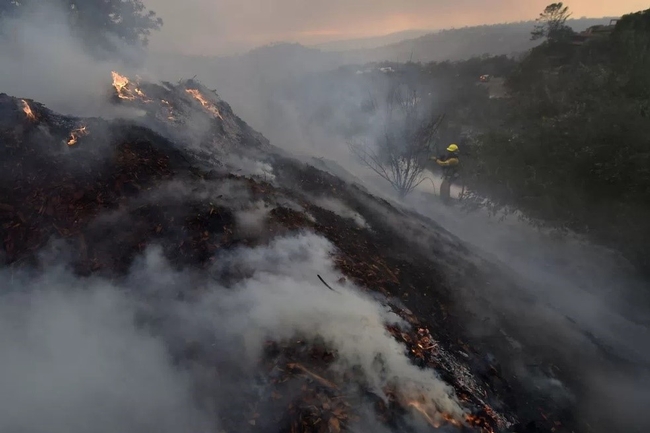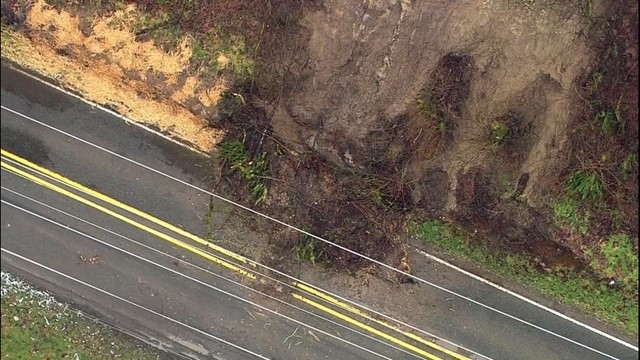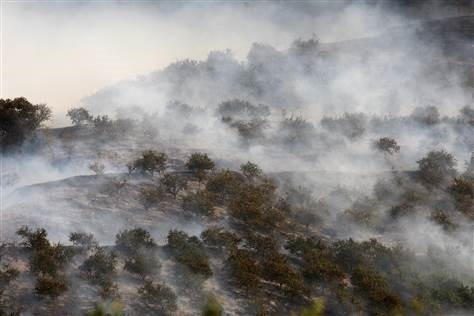
Posts Tagged: prevention
After the Fire and Before the Rain, What to Do?
Firefighters from all over the country worked around the clock to put out fires throughout the state of California. Fires could be devastating to growers and, in some ways, they could be beneficial by reducing populations of weeds and unwanted vegetation. However, after the loss of vegetation after a fire, growers have to prepare for the next possible disaster- mudslides, debris flow and flashfloods. Vegetation that once secured soil and gravel, preventing erosion on mountain and hill slopes is no longer there. Instead the waxy residue from burnt plant debris has formed into a baked waxy layer that prevents water from infiltrating more than a few inches into the soil, creating a water-proof surface layer. When a significant amount of rainfall occurs after a fire, it becomes an environment for a mudslide.
According to Randy Brooks, author of the article “After the Fires: Hydrophobic Soils,” during a fire, burning plants release gases from waxy plant substances that permeate through the soil pore space, coating soil particles with a hydrophobic substance, thus repelling water. Over time, the wax-like, hydrophobic layer that has formed a few inches below the soil could persist in repelling water causing damage years later. Orchard trees with shallow roots can be destroyed and/or develop weakened root systems if a mudslide occurs post-fire. As rain continues to fall, large chunks of topsoil can break loose and slide down sloped landscapes. In some cases, mud and debris can exceed 35 mph, causing massive damage and major mudslides.
Rapid moving mudslides can enter into infiltration basins, irrigation canals, and reservoirs moving silty-clay sand suspension sediment that could clog pumps and irrigation lines creating an expensive problem for growers.
Erosion in Orchards Post-Fire
Post-fire rains result in the transport of fertile soil particles into downstream waterways. These sediments can carry unwanted pesticides and nutrients that adhere to them. Erosion problems can include water pollution, loss of soil quality, increased flooding, impairment of stream ecosystems, decreased groundwater storage, release of carbon, slope failures, degradation of habitat and loss of species, damage to downstream lands and properties. Not to mention the amount of time and costs associated with addressing these issues.
Preventable Management Practices
Orchard floor management can include anything from the addition of soil amendments to changes in tillage practices. One way to minimize soil erosion is to implement management practices that improve soil structure. Soil structure is the arrangement of mineral particles into aggregates. A well-structured soil having stable aggregates can easily accommodate infiltrating water that decreases runoff and reduces erosion. In addition, stable aggregates resist particle detachment, prevent the formation of crusts, and are less susceptible to compaction. Light tillage where possible can break up the hydrophobic topsoil layer post-fire, followed by planting a cover crop, such as a grass or a forb can prevent soil erosion and be a moderate barrier in the event of a mudslide.
Mature avocado groves have high soil organic matter (SOM) due to leaf mulch and fine rootlets that die and decompose in the shallow soils. Soil organic matter promotes good soil aggregation and stable aggregates. The form of SOM that binds soil particles together into aggregates is called humus, which consists of highly decomposed organic material. Humus results from the breakdown of mulches, roots and any amended organic materials like compost or other supplemental mulches.
Periodic application of organic materials is a proven method for improving the water-infiltration capacity of certain soils: those that suffer from weak structure due to low organic matter content.
In many situations it is neither practical nor feasible to add soil amendments as an erosion control practice. Cover crops are an excellent alternative to reduce soil erosion. They protect the soil from raindrop impact, prevent the formation of surface crusts, increase infiltration rates, and intercept sediment-rich runoff. Cover crops are also a great source of SOM. Critical aspects to consider are nutrient and water competition with crops, cost of additional water for irrigation, shade tolerance, crop height, and maintenance practices such as mowing.
Like most management practices, cover cropping has disadvantages, too. All cover crops use water, some are invasive, some serve as habitat for pests, some can increase the potential for frost damage, and they may be costly to establish.
Management practices are ever changing for prevention and protection of orchards every year especially against fire and mudslides. Being informed and assessing the situation post-fire adds value to how we can evaluate the cost of protecting orchards and economically prepare fields from mudslides damages.
Avocado Orchards in Fire Season
The very fact that avocados can be grown in hard to get to places means that the trees are also in areas that are subject to wildfire damage. Recently several hundred acres of avocado burned in the foothills. The fire was fanned by high winds and low humidity.
Every year there are avocado trees that burn, either through careless attention to early morning fires that pickers build, wildfires or car accidents. A grower needs to be patient and observant to bring the trees back into production.
Although injury to foliage and young growth is visible within a few days of the fire, the full extent of the damage may not be known for several months or possibly the next growing season. In the case of severe injury, die-back may continue to occur for several months after the fire. New growth that occurs after the fire may suddenly collapse the following year when the growth is tested by Santa Ana conditions.
The important rule to follow after a fire is to do nothing - don't prune, don't fertilize and maybe don't water. Or rather, water very carefully. Dry winds may have sucked the water out of the ground and may need to be replenished. The fire may have burned the irrigation lines and need to be replaced.
In the meantime, if the tree has been defoliated by the fire, it has lost its ability to transpire water. Watering a tree with no leaves will set up those conditions that are conducive to root rot. Until the tree begins to leaf out, watch soil moisture to decide how much water the trees are pulling out of the soil. The emitters should be capped or plugged on some leafless trees. Then as the tree puts on new growth, shallow, infrequent irrigations should start. This may mean replacing the 10 gph microsprinkler with a 1 gph dripper if only a portion of the orchard has been burned and the rest of the trees need their usual amounts and frequency of water.
The avocado has a tremendous ability to come back from fire and frost damage. However, the tree will tell you where it is coming back. It will start pushing growth where the tree is still healthy. It may take 3 to 6 months for this growth to occur.
Delay pruning until the tree clearly shows where it is going to regrow. By waiting, you save the expense of having to return sometime later to remove more wood and also will be able to save the maximum about of tree.
An activity the grower can perform is whitewashing. The defoliated tree can be further damaged by sunburn after it has lost its protective cover of leaves. The upper surface of horizontal limbs and the south sides of exposed trunks are the most affected. The whitewash can delay the appearance of new growth, but it does not affect total growth. There is usually no value in applying the whitewash to small limbs.
There are various commercial whitewashes on the market. The easiest to prepare is the cheapest white latex paint on the market mixed with water to the extent that it will go through a sprayer.
Avocado trees have a great ability to recover after fire damage. Even trees killed below the bud union will frequently develop into good trees if they are rebudded and given good care. Trees which do not put out vigorous sprouts should be removed. Interplanting avocados would rarely be advisable because of their rapid recovery.
Fire Information:
http://ceventura.ucanr.edu/Agricultural_Threats/Fire_Information/

IMG 2031
Phire, Phlood, Phreeze and Fytophthora
A great idea from Ed McFadden of Philmore
You can always do something to prevent or correct the Big 4 that seem to strike avocados on a regular basis somewhere in California. Avocados in the back country are right up against areas that can burn easily. A fast fire can send embers into an orchard which can burn through the thick leaves in a slow burn. If it gets up against leaves piled up against the trunk, it can girdle the tree, killing it. The slow burn can continue through the orchard torching the irrigation lines. With a small fire break where the leaves are removed in a small alley, the burn can be slowed or stopped.
Leaves are great for erosion control, for nutrient cycling and disease control, but if they mean increasing potential for fire spread, it's a good idea to remove a little of it. Ed has found that a backpack blower can rapidly remove leaves from around the base of trees and create a narrow fire break that can reduce fire damage to trees.
Avocado orchards are notable for their ability to actually reduce fire hazard and slow major fires as has been shown in fires in San Diego, Ventura and Santa Barbara. This is partly due to running sprinklers during wild fire. But tree loss can still occur, especially when electricity goes down and pumps can't run.
Little rain this year or too much rain this year can always pose a hazard to avocado orchards. This sure seems like a good idea to me. And maybe it's time to start thinking about fire season now.
Photos: Cleared alley and trunk.
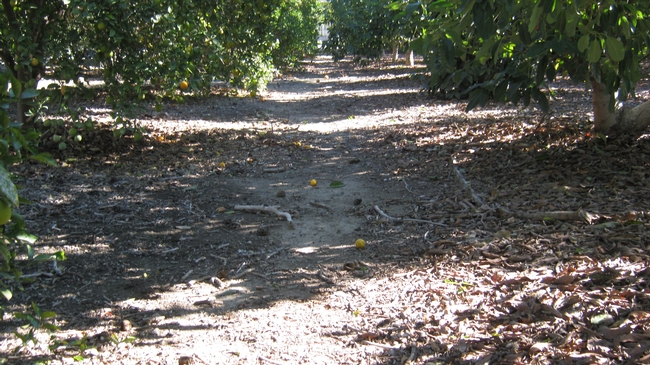
fire alley
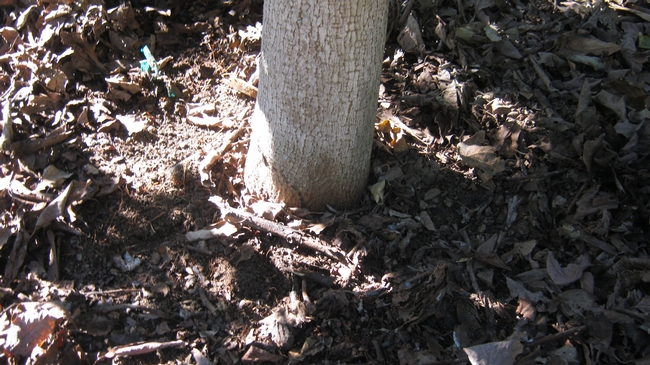
fire trunk
What Lessons Have We Learned About Fire Readiness and Prevention?
Sonia Rios, Area Subtropical Horticulture Advisor, Riverside & San Diego Counties
Henry Herrera, Forester, California Department of Forestry and Fire Protection (CAL FIRE)
Gary Bender, Subtropical Horticulture Advisor, San Diego County
This is a reposting of a blog from 2015 that is still pertinent today.
Vegetation Weed Management
Vegetation weed management is something CAL FIRE feels strongly about, especially during times of drought. CAL FIRE interprets this type of weed management as a fuel reduction or fuel modification practice which helps growers create defensible space around their habitable structures or groves. Defensible space is a buffer between property (i.e. homes, groves, infrastructure) and plants (i.e. brush, trees, etc.) or other items surrounding the property to be protected that could catch fire and act as fuel.
Defensible space is needed to slow the spread of a wildfire and improves the safety of firefighters defending properties. Defensible space reduces the fire risk and creates space that firefighters can use as a tool to work safely and suppress a wildfire and to defend a structure or other property in the event of a wildfire. Fuel modification/reduction projects include defensible space around structures, fuelbreaks along roads and groves, ridge tops, or around property lines and other fire fuel reduction activities that lessen the risk of wildfires to communities. Fuel reduction projects usually remove cut vegetation from the site either through burning or haul-away methods. Fuel modification projects usually leave the cut vegetation on site in the form of wood chips or scattered material. These types of projects break up the lateral and horizontal vegetative continuity which reduced rates of fire spread, fire intensity, and flame heights which increase firefighter's chances of suppressing fires.
Prunings piled in draws within or around the groves can also be particularly damaging because they are dried vegetation which pose an increased fire danger due to the fact that piles of vegetation can easily ignite and smolder for a long time creating a challenge to firefighters. Vegetation that is piled in draws or other waterways can also obstruct water flow during rain events which could lead to erosion and flooding.
How to Keep our Growers and Groves Safe
Preventative Measures:
These preventive measures can be suggested for groves in areas of high fire hazard are often counter to other measures which might reduce erosion or improve root disease control, so a balance should be strived for (Goodall 1965):
1. Remove all combustible material from around the trunks of the trees for a distance of two to three feet.
2. Prune off low-lying limbs, those that are low enough to accumulate more than the normal inch or so of leaf mulch.
3. Remove from the orchard all broken limbs, deadwood and other combustible debris.
4. Clear brush, trees and other heavy vegetation away from edge of orchard for a distance of at least 50 feet.
5. Do not pile brush or other combustible material in draws or canyons, or around the edges of groves.
6. Apply sprinkler water for as long a period in advance of the fire as possible so as to have everything wet. Water during the fire would obviously be desirable but often is lacking because of lack of pressure or speed of the movement of the fire.
7. Use steel pipe and risers for above ground sprinkler systems.
Growers can also look for other tips on preventive measures on the Cal Fire website: http://calfire.ca.gov/fire_prevention/fire_prevention.php.
After a Fire
It is nearly impossible to determine the extent of damage to the wood of the tree immediately after the fire. The most critical part of the tree is the main trunk. The bark from just above the ground to about two feet high can become hot enough to kill the cambium, the growth layer between the bark and wood. When the cambium is killed, the tree is girdled and will die (Goodall 1965). Suckers will eventually grow from below the graft union of these trees; these suckers can then be grafted to an appropriate variety. However, many trees in the grove may still be alive internally because there was a quick burn through the grove, or the leaves merely died from heat generated by burning surrounding trees, vegetation and mulch (Bender 2012).
According to Bender (2012), fire damaged trees that have leaves that are completely brown do not use water, but there may be trees that have escaped the fire in the irrigation block and these need to be irrigated as soon as possible. The first thing to do is to repair the irrigation system. Risers, sprinklers, pressure regulators and poly-hose on the ground are probably melted and should be replaced as soon as possible. PVC pipe that is buried underground is usually fine, depending on its depth and fire intensity. If part of the trees in the irrigation block are alive and partly damaged, it would probably be best to roll out poly-hose onto the damaged trees and set up a separate irrigation block. As the trees recover and start using water, you can eventually go back to the permanent system.
Trees that are heavily damaged do not use as much water (therefore transpiration is reduced significantly), but their feeder roots need to be watered and short irrigations should occur to replace water evaporating off of the soil surface. Start with a one hour irrigation and monitor the soil closely, irrigating too heavily could lead to the onset of root rot. Do not irrigate damaged trees on its original schedule; a ten hour irrigation will not “force” the trees to grow back sooner, and roots could be easily damaged by lack of oxygen in the lower soil profiles due to water accumulating and the soil becoming saturated.
Every fire is different, so experiences vary. It may take several months to be able to observe whether the bark is killed all the way to the cambium or not. Thus, we recommend against pruning until new growth appears to indicate where the wood is alive. According to Bender (2012), an alternative method which is rather unique to the avocado industry, the burned trees can all be stumped immediately and allowed to re-grow. “Stumping” is a normal practice in the industry when avocado trees have reached such heights that fruit is high off the ground and picking becomes difficult. In many of the groves that were burned, stumping was probably needed anyway; therefore after a burn stumping would be a reasonable alternative for many growers.
Fire damaged trees should be whitewashed on the south side of the limbs. Goodall (1965) also suggests to save expenses, fertilizer and pest control can be postponed for a year or so.
According to Bender (2012), if the goal of the grower is to bring trees back into production as soon as possible, the avocado tree will usually recover production faster if the grower is patient and prunes only the dead wood three months after the fire. Unfortunately, this practice creates a permanent problem in the grove as far as irrigation scheduling and application. Mixing full-grown trees (untouched by the fire) with partially pruned trees (and stumped trees) in an irrigation block means that some trees will be over-watered, or under-watered, depending on their size. Adjustments can be made in the sprinkler sizes, but generally this is an undesirable cultural practice due to every tree needing a different rate of irrigation and can this can also add to labor and equipment costs.
If the goal is to reduce the size of all trees in the irrigation block to a manageable size, then stumping the block immediately after the fire is the best solution. Trees will be out of production for two years and have about 50% production in the third year, and some re-grafting may have to be done, but fertilizing and watering properly is manageable.
A third option could be to scaffold all trees in an irrigation block to 12' in height. This would get rid of a lot of dead wood immediately, and might allow the trees to come back in production faster than the stumping the trees.
It is helpful for growers to know the value, for insurance purposes, of trees that are lost due to fire. Determining the value of a tree in an orchard is not a simple matter because one must take into account the income lost if the tree had been producing, as well as the costs of planting and maintaining the new tree. Also, the income from the new tree, once it comes into bearing, helps to defray the costs involved in bringing the tree to maturity. Examples can be seen here at the UCCE website: http://ceventura.ucanr.edu/Agricultural_Threats/Fire_Information/. Assessing tree loss can be calculated at the UC DAvis Ag Econoimics website: https://coststudies.ucdavis.edu/en/tree-vine-loss/
Record-low rainfall, extreme heat and a statewide drought has caused a significant increase in wildfires and a need for Californians to participate in fire-prevention tactics, including growers. According to CAL FIRE, in order to prevent wildfires and property damage, homeowners are asked to maintain “defensible space” around their house and groves year round and not use powered equipment outdoors when it's hot, dry or windy. Wildfire prevention such as defensible space, keeping properties cleared of dried vegetation, and public education is the best long term solution.
Photo 1: An inmate firefighter crew battles a fire in an avocado grove outside Fallbrook, California, May 14, 2014. Photo: Sandy Huffaker
Photo 2: Low intensity fire damage on avocados. Photo: U.S. Today
Photo 3: A CAL FIRE inmate crew fighting a wildfire in an avocado grove, May 2014. Photo: Sandy Huffaker
Work Cited
Bender, Gary. 2012. Recovery from Fire Damage in Avocado Groves. UCCE San Diego Website: cesandiego.ucanr.edu/files/54279.doc. [Accessed June 16, 2015].
Goodall, G. E. Avocados and the Coyote Fire. California Avocado Society 1965 Yearbook 49: 81-83.
Ventura Co UCCE publication. Calculate Cost of Fire Damage to Avocado and Citrus Trees. Growing Avocados in Ventura County Reference Book. UCCE Ventura

fire fighting
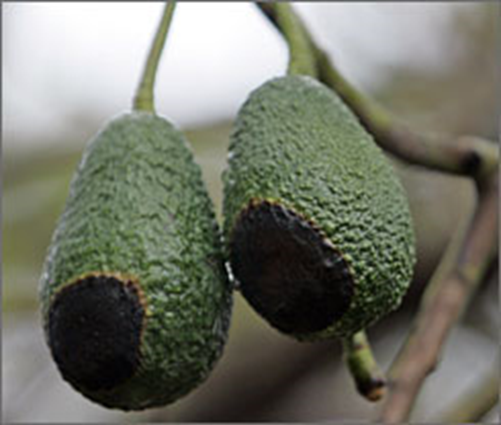
fire damaged avocado fruit

firefighters in avocado grove

